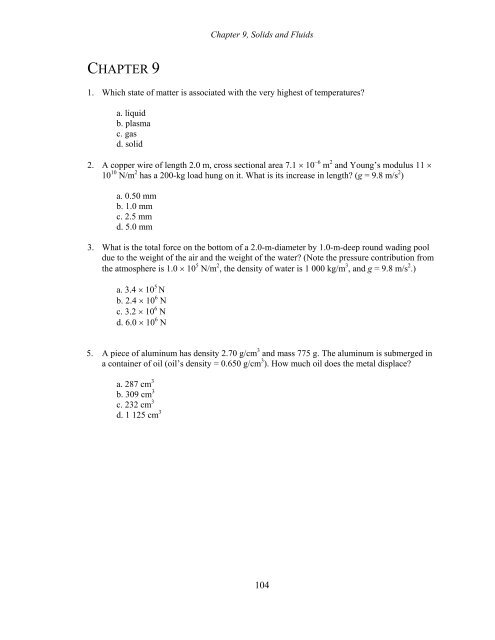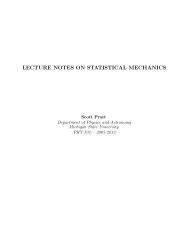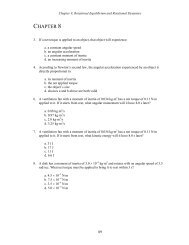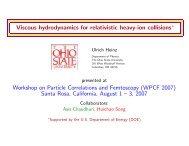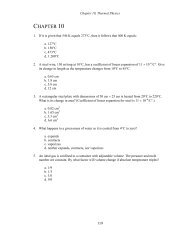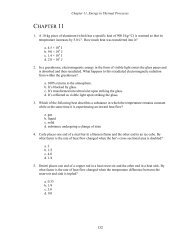1.Which of the following states of matter is associated with the very ...
1.Which of the following states of matter is associated with the very ...
1.Which of the following states of matter is associated with the very ...
Create successful ePaper yourself
Turn your PDF publications into a flip-book with our unique Google optimized e-Paper software.
Chapter 9, Solids and Fluids<br />
CHAPTER 9<br />
1. Which state <strong>of</strong> <strong>matter</strong> <strong>is</strong> <strong>associated</strong> <strong>with</strong> <strong>the</strong> <strong>very</strong> highest <strong>of</strong> temperatures<br />
a. liquid<br />
b. plasma<br />
c. gas<br />
d. solid<br />
2. A copper wire <strong>of</strong> length 2.0 m, cross sectional area 7.1 × 10 −6 m 2 and Young’s modulus 11 ×<br />
10 10 N/m 2 has a 200-kg load hung on it. What <strong>is</strong> its increase in length (g = 9.8 m/s 2 )<br />
a. 0.50 mm<br />
b. 1.0 mm<br />
c. 2.5 mm<br />
d. 5.0 mm<br />
3. What <strong>is</strong> <strong>the</strong> total force on <strong>the</strong> bottom <strong>of</strong> a 2.0-m-diameter by 1.0-m-deep round wading pool<br />
due to <strong>the</strong> weight <strong>of</strong> <strong>the</strong> air and <strong>the</strong> weight <strong>of</strong> <strong>the</strong> water (Note <strong>the</strong> pressure contribution from<br />
<strong>the</strong> atmosphere <strong>is</strong> 1.0 × 10 5 N/m 2 , <strong>the</strong> density <strong>of</strong> water <strong>is</strong> 1 000 kg/m 3 , and g = 9.8 m/s 2 .)<br />
a. 3.4 × 10 5 N<br />
b. 2.4 × 10 6 N<br />
c. 3.2 × 10 6 N<br />
d. 6.0 × 10 6 N<br />
5. A piece <strong>of</strong> aluminum has density 2.70 g/cm 3 and mass 775 g. The aluminum <strong>is</strong> submerged in<br />
a container <strong>of</strong> oil (oil’s density = 0.650 g/cm 3 ). How much oil does <strong>the</strong> metal d<strong>is</strong>place<br />
a. 287 cm 3<br />
b. 309 cm 3<br />
c. 232 cm 3<br />
d. 1 125 cm 3 104
Chapter 9, Solids and Fluids<br />
6. A piece <strong>of</strong> aluminum has density 2.70 g/cm 3 and mass 775 g. The aluminum <strong>is</strong> submerged in<br />
a container <strong>of</strong> oil <strong>of</strong> density 0.650 g/cm 3 . A spring balance <strong>is</strong> attached <strong>with</strong> string to <strong>the</strong> piece<br />
<strong>of</strong> aluminum. What reading will <strong>the</strong> balance reg<strong>is</strong>ter in grams (g) for <strong>the</strong> submerged metal<br />
a. 960 g<br />
b. 775 g<br />
c. 588 g<br />
d. 190 g<br />
7. A block <strong>of</strong> wood has density 0.50 g/cm 3 and mass 1 500 g. It floats in a container <strong>of</strong> oil (<strong>the</strong><br />
oil’s density <strong>is</strong> 0.75 g/cm 3 ). What volume <strong>of</strong> oil does <strong>the</strong> wood d<strong>is</strong>place<br />
a. 3 000 cm 3<br />
b. 2 000 cm 3<br />
c. 1 500 cm 3<br />
d. 1 000 cm 3<br />
11. In a large tank <strong>of</strong> liquid, <strong>the</strong> hydrostatic pressure at a given depth <strong>is</strong> a function <strong>of</strong>:<br />
a. depth<br />
b. surface area<br />
c. liquid density<br />
d. choices a and c are both valid<br />
14. A 15 000-N car on a hydraulic lift rests on a cylinder <strong>with</strong> a p<strong>is</strong>ton <strong>of</strong> radius 0.20 m. If a<br />
connecting cylinder <strong>with</strong> a p<strong>is</strong>ton <strong>of</strong> 0.040-m radius <strong>is</strong> driven by compressed air, what force<br />
must be applied to th<strong>is</strong> smaller p<strong>is</strong>ton in order to lift <strong>the</strong> car<br />
a. 600 N<br />
b. 1 500 N<br />
c. 3 000 N<br />
d. 15 000 N<br />
15. By what factor <strong>is</strong> <strong>the</strong> total pressure greater at a depth <strong>of</strong> 850 m in water than at <strong>the</strong> surface<br />
where pressure <strong>is</strong> one atmosphere (water density = 1.0 × 10 3 kg/m 3 , 1 atmosphere pressure =<br />
1.01 × 10 5 N/m 2 and g = 9.8 m/s 2 )<br />
a. 100<br />
b. 83<br />
c. 74<br />
d. 19<br />
16. What volume <strong>of</strong> water <strong>is</strong> d<strong>is</strong>placed by a submerged 2.0-kg cylinder made <strong>of</strong> solid<br />
aluminum (aluminum density = 2.7 × 10 3 kg/m 3 and water density = 1.0 × 10 3 kg/m 3 )<br />
a. 7.4 × l0 −4 m 3<br />
b. 1.4 × 10 3 m 3<br />
c. 9.9 × 10 3 m 3<br />
d. 6.0 × 10 2 m 3 105
Chapter 9, Solids and Fluids<br />
17. A ping-pong ball has an average density <strong>of</strong> 0.0840 g/cm 3 and a diameter <strong>of</strong> 3.80 cm.<br />
What force would be required to keep <strong>the</strong> ball completely submerged under water<br />
a. 1.000 N<br />
b. 0.788 N<br />
c. 0.516 N<br />
d. 0.258 N<br />
18. A cube <strong>of</strong> wood <strong>of</strong> density 0.78 g/cm 3 <strong>is</strong> 10 cm on a side. When placed in water, what height<br />
<strong>of</strong> <strong>the</strong> block will float above <strong>the</strong> surface (water density = 1.00 g/cm 3 )<br />
a. 7.8 cm<br />
b. 5.0 cm<br />
c. 2.2 cm<br />
d. 6.4 cm<br />
19. The bottom <strong>of</strong> a flat-bottomed aluminum boat has an area <strong>of</strong> 4.0 m 2 and <strong>the</strong> boat’s mass <strong>is</strong> 60<br />
kg. When set afloat in water, how far below <strong>the</strong> water surface <strong>is</strong> <strong>the</strong> boat bottom (water<br />
density = 1.0 × 10 3 kg/m 3 )<br />
a. 0.060 m<br />
b. 0.015 m<br />
c. 0.030 m<br />
d. 0.075 m<br />
20. The bottom <strong>of</strong> a flat-bottomed aluminum boat has area = 4.0 m 2 and mass = 60 kg. If two<br />
f<strong>is</strong>hermen and <strong>the</strong>ir f<strong>is</strong>hing gear <strong>with</strong> total mass <strong>of</strong> 300 kg are placed in <strong>the</strong> boat, how much<br />
lower will <strong>the</strong> boat ride in <strong>the</strong> water (H 2 O density = 1.0 × 10 3 kg/m 3 )<br />
a. 0.15 m<br />
b. 0.12 m<br />
c. 0.075 m<br />
d. 0.060 m<br />
21. A uniform pressure <strong>of</strong> 7.0 × 10 5 N/m 2 <strong>is</strong> applied to all six sides <strong>of</strong> a copper cube. What <strong>is</strong> <strong>the</strong><br />
percentage change in volume <strong>of</strong> <strong>the</strong> cube (for copper, B = 14 × 10 10 N/m 2 )<br />
a. 2.4 × 10 −2 %<br />
b. 0.4 × 10 −2 %<br />
c. 8.4 × 10 −2 %<br />
d. 0.5 × 10 −3 %<br />
106
Chapter 9, Solids and Fluids<br />
23. If <strong>the</strong> column <strong>of</strong> mercury in a barometer stands at 72.6 cm, what <strong>is</strong> <strong>the</strong> atmospheric pressure<br />
(The density <strong>of</strong> mercury <strong>is</strong> 13.6 × 10 3 kg/m 3 and g = 9.80 m/s 2 )<br />
a. 0.968 × 10 5 N/m 2<br />
b. 1.03 × 10 5 N/m 2<br />
c. 0.925 × 10 5 N/m 2<br />
d. 1.07 × 10 5 N/m 2<br />
24. A solid rock, suspended in air by a spring scale, has a measured mass <strong>of</strong> 9.00 kg. When <strong>the</strong><br />
rock <strong>is</strong> submerged in water, <strong>the</strong> scale reads 3.30 kg. What <strong>is</strong> <strong>the</strong> density <strong>of</strong> <strong>the</strong> rock (water<br />
density = 1 000 kg/m 3 )<br />
a. 4.55 × 10 3 kg/m 3<br />
b. 3.50 × 10 3 kg/m 3<br />
c. 1.20 × 10 3 kg/m 3<br />
d. 1.58 × 10 3 kg/m 3<br />
25. Bar One has a Young’s modulus that <strong>is</strong> bigger than that <strong>of</strong> Bar Two. Th<strong>is</strong> indicates Bar One:<br />
a. <strong>is</strong> longer than Bar Two.<br />
b. has a greater cross-sectional area than Bar Two.<br />
c. has a greater elastic limit than Bar Two.<br />
d. <strong>is</strong> made <strong>of</strong> material that <strong>is</strong> different from Bar Two.<br />
26. Consider two steel rods, A and B. B has three times <strong>the</strong> area and twice <strong>the</strong> length <strong>of</strong> A, so<br />
Young’s modulus for B will be what factor times Young’s modulus for A<br />
a. 3.0<br />
b. 0.5<br />
c. 1.5<br />
d. 1.0<br />
107
Chapter 9, Solids and Fluids<br />
28. As ice floats in water, about 10% <strong>of</strong> <strong>the</strong> ice floats above <strong>the</strong> surface <strong>of</strong> <strong>the</strong> water. If we float<br />
some ice in a glass <strong>of</strong> water, what will happen to <strong>the</strong> water level as <strong>the</strong> ice melts<br />
a. The water level will r<strong>is</strong>e 10% <strong>of</strong> <strong>the</strong> volume <strong>of</strong> <strong>the</strong> ice that melts.<br />
b. The water level will r<strong>is</strong>e, but not as much as <strong>the</strong> 10% indicated in answer A.<br />
c. The water level will remain unchanged.<br />
d. The water level will become lower.<br />
31. A large stone <strong>is</strong> resting on <strong>the</strong> bottom <strong>of</strong> <strong>the</strong> swimming pool. The normal force <strong>of</strong> <strong>the</strong> bottom<br />
<strong>of</strong> <strong>the</strong> pool on <strong>the</strong> stone <strong>is</strong> equal to <strong>the</strong>:<br />
a. weight <strong>of</strong> <strong>the</strong> stone.<br />
b. weight <strong>of</strong> <strong>the</strong> water d<strong>is</strong>placed.<br />
c. sum <strong>of</strong> <strong>the</strong> weight <strong>of</strong> <strong>the</strong> stone and <strong>the</strong> weight <strong>of</strong> <strong>the</strong> d<strong>is</strong>placed water.<br />
d. difference between <strong>the</strong> weight <strong>of</strong> <strong>the</strong> stone and <strong>the</strong> weight <strong>of</strong> <strong>the</strong> d<strong>is</strong>placed water.<br />
32. The pressure inside a commercial airliner <strong>is</strong> maintained at 1.00 atm (10 5 Pa). What <strong>is</strong> <strong>the</strong> net<br />
outward force exerted on a 1.0 m × 2.0 m cabin door if <strong>the</strong> outside pressure <strong>is</strong> 0.30 atm<br />
a. 140 N<br />
b. 1 400 N<br />
c. 14 000 N<br />
d. 140 000 N<br />
33. A stonecutter’s ch<strong>is</strong>el has an edge area <strong>of</strong> 0.50 cm 2 . If <strong>the</strong> ch<strong>is</strong>el <strong>is</strong> struck <strong>with</strong> a force <strong>of</strong> 45<br />
N, what <strong>is</strong> <strong>the</strong> pressure exerted on <strong>the</strong> stone<br />
a. 9 000 Pa<br />
b. 90 000 Pa<br />
c. 450 000 Pa<br />
d. 900 000 Pa<br />
36. The Greenland ice sheet can be one km thick. Estimate <strong>the</strong> pressure underneath <strong>the</strong> ice. (The<br />
density <strong>of</strong> ice <strong>is</strong> 918 kg/m 3 .)<br />
a. 9.0 × 10 5 Pa (9 atm)<br />
b. 2.5 × 10 6 Pa (25 atm)<br />
c. 4.5 × 10 6 Pa (45 atm)<br />
d. 9.0 × 10 6 Pa (90 atm)<br />
37. The water behind Grand Coulee Dam <strong>is</strong> 1 200 m wide and 150 m deep. Find <strong>the</strong> hydrostatic<br />
force on <strong>the</strong> back <strong>of</strong> <strong>the</strong> dam. (Hint: <strong>the</strong> total force = average pressure × area)<br />
a. 5.2 × 10 9 N<br />
b. 8.8 × 10 10 N<br />
c. 13.2 × 10 10 N<br />
d. 18.0 × 10 10 N<br />
108
Chapter 9, Solids and Fluids<br />
38. A blimp <strong>is</strong> filled <strong>with</strong> 400 m 3 <strong>of</strong> helium. How big a payload can <strong>the</strong> balloon lift (The density<br />
<strong>of</strong> air <strong>is</strong> 1.29 kg/m 3 ; <strong>the</strong> density <strong>of</strong> helium <strong>is</strong> 0.18 kg/m 3 .)<br />
a. 111 kg<br />
b. 129 kg<br />
c. 215 kg<br />
d. 444 kg<br />
40. An ideal fluid flows through a pipe made <strong>of</strong> two sections <strong>with</strong> diameters <strong>of</strong> 1.0 and 3.0<br />
inches, respectively. The speed <strong>of</strong> <strong>the</strong> fluid flow through <strong>the</strong> 3.0-inch section will be what<br />
factor times that through <strong>the</strong> 1.0-inch section<br />
a. 6.0<br />
b. 9.0<br />
c. 1/3<br />
d. 1/9<br />
41. The flow rate <strong>of</strong> a liquid through a 2.0-cm-radius pipe <strong>is</strong> 0.008 0 m 3 /s. The average fluid<br />
speed in <strong>the</strong> pipe <strong>is</strong>:<br />
a. 0.64 m/s<br />
b. 2.0 m/s<br />
c. 0.040 m/s<br />
d. 6.4 m/s<br />
42. Think <strong>of</strong> Bernoulli’s equation as it pertains to an ideal fluid flowing through a horizontal<br />
pipe. Imagine that you take measurements along <strong>the</strong> pipe in <strong>the</strong> direction <strong>of</strong> fluid flow. What<br />
happens to <strong>the</strong> sum <strong>of</strong> <strong>the</strong> pressure and energy per unit volume<br />
a. it increases as <strong>the</strong> pipe diameter increases<br />
b. it decreases as <strong>the</strong> pipe diameter increases<br />
c. it remains constant as <strong>the</strong> pipe diameter increases<br />
d. no choices above are valid<br />
109
Chapter 9, Solids and Fluids<br />
43. An ideal fluid, <strong>of</strong> density 0.85 × 10 3 kg/m 3 , flows at 0.25 kg/s through a pipe <strong>of</strong> radius 0.010<br />
m. What <strong>is</strong> <strong>the</strong> fluid speed<br />
a. 0.85 m/s<br />
b. 1.3 m/s<br />
c. 3.0 m/s<br />
d. 0.94 m/s<br />
44. An ideal fluid, <strong>of</strong> density 0.90 × 10 3 kg/m 3 , flows at 6.0 m/s through a level pipe <strong>with</strong> radius<br />
<strong>of</strong> 0.50 cm. The pressure in <strong>the</strong> fluid <strong>is</strong> 1.3 × 10 5 N/m 2 . Th<strong>is</strong> pipe connects to a second level<br />
pipe, <strong>with</strong> radius <strong>of</strong> 1.5 cm. Find <strong>the</strong> speed <strong>of</strong> flow in <strong>the</strong> second pipe.<br />
a. 54 m/s<br />
b. 18 m/s<br />
c. 0.67 m/s<br />
d. 0.33 m/s<br />
45. The flow rate <strong>of</strong> blood through <strong>the</strong> average human aorta, <strong>of</strong> radius 1.0 cm, <strong>is</strong> about 90 cm 3 /s.<br />
What <strong>is</strong> <strong>the</strong> speed <strong>of</strong> <strong>the</strong> blood flow through <strong>the</strong> aorta<br />
a. 14 cm/s<br />
b. 32 cm/s<br />
c. 37 cm/s<br />
d. 29 cm/s<br />
48. Air pressure <strong>is</strong> 1.0 × 10 5 N/m 2 , air density <strong>is</strong> 1.3 kg/m 3 , and <strong>the</strong> density <strong>of</strong> s<strong>of</strong>t drinks <strong>is</strong> 1.0 ×<br />
10 3 kg/m 3 . If one blows carefully across <strong>the</strong> top <strong>of</strong> a straw sticking up 0.100 m from <strong>the</strong><br />
liquid in a s<strong>of</strong>t drink can, it <strong>is</strong> possible to make <strong>the</strong> s<strong>of</strong>t drink r<strong>is</strong>e half way up <strong>the</strong> straw and<br />
stay <strong>the</strong>re. How fast must <strong>the</strong> air be blown across <strong>the</strong> top <strong>of</strong> <strong>the</strong> straw<br />
a. 76 m/s<br />
b. 27 m/s<br />
c. 19 m/s<br />
d. 0.99 m/s<br />
49. A hole <strong>is</strong> poked through <strong>the</strong> metal side <strong>of</strong> a drum holding water. The hole <strong>is</strong> 18 cm below <strong>the</strong><br />
water surface. What <strong>is</strong> <strong>the</strong> initial speed <strong>of</strong> outflow<br />
a. 1.9 m/s<br />
b. 2.96 m/s<br />
c. 3.2 m/s<br />
d. 3.5 m/s<br />
52. A fountain sends water to a height <strong>of</strong> 100 m. What must be <strong>the</strong> pressurization (above<br />
atmospheric) <strong>of</strong> <strong>the</strong> underground water system (1 atm = 10 5 N/m 2 )<br />
a. 1 atm<br />
b. 4.2 atm<br />
c. 7.2 atm<br />
d. 9.8 atm<br />
110
Chapter 9, Solids and Fluids<br />
58. Water <strong>is</strong> sent from a fire hose at 30 m/s at an angle <strong>of</strong> 30° above <strong>the</strong> horizontal. What <strong>is</strong> <strong>the</strong><br />
maximum height reached by <strong>the</strong> water<br />
a. 7.5 m<br />
b. 11 m<br />
c. 15 m<br />
d. 19 m<br />
60. A fluid <strong>is</strong> drawn up through a tube as shown below. The atmospheric pressure <strong>is</strong> <strong>the</strong> same at<br />
both ends. Use Bernoulli’s equation to determine <strong>the</strong> speed <strong>of</strong> fluid flow out <strong>of</strong> <strong>the</strong> tank. If<br />
<strong>the</strong> height difference from <strong>the</strong> top <strong>of</strong> <strong>the</strong> tank to <strong>the</strong> bottom <strong>of</strong> <strong>the</strong> siphon <strong>is</strong> 1.0 m, <strong>the</strong>n <strong>the</strong><br />
speed <strong>of</strong> outflow <strong>is</strong><br />
a. 1.1 m/s<br />
b. 2.2 m/s<br />
c. 4.4 m/s<br />
d. 8.8 m/s<br />
v<br />
1 m<br />
61. How deep under <strong>the</strong> surface <strong>of</strong> a lake would <strong>the</strong> pressure be double that at <strong>the</strong> surface (1<br />
atm = 1.01 × 10 5 Pa)<br />
a. 1.00 m<br />
b. 9.80 m<br />
c. 10.3 m<br />
d. 32.2 m<br />
62. It takes 2.0 minutes to fill a gas tank <strong>with</strong> 40 liters <strong>of</strong> gasoline. If <strong>the</strong> pump nozzle <strong>is</strong> 1.0 cm<br />
in radius, what <strong>is</strong> <strong>the</strong> average speed <strong>of</strong> <strong>the</strong> gasoline as it leaves <strong>the</strong> nozzle (1 000 liters = one<br />
cubic meter)<br />
a. 0.27 m/s<br />
b. 1.1 m/s<br />
c. 11 m/s<br />
d. 64 m/s<br />
111
Chapter 9, Solids and Fluids<br />
63. A heavily loaded boat <strong>is</strong> floating in a pond. The boat sinks because <strong>of</strong> a leak. What happens<br />
to <strong>the</strong> surface level <strong>of</strong> <strong>the</strong> pond<br />
a. It stays <strong>the</strong> same.<br />
b. It goes up.<br />
c. It goes down.<br />
d. More information <strong>is</strong> needed to reach a conclusion.<br />
64. A heavily loaded boat <strong>is</strong> floating in a pond. The boat starts to sink because <strong>of</strong> a leak but<br />
quick action plugging <strong>the</strong> leak stops <strong>the</strong> boat from going under although it <strong>is</strong> now deeper in<br />
<strong>the</strong> water. What happens to <strong>the</strong> surface level <strong>of</strong> <strong>the</strong> pond<br />
a. It stays <strong>the</strong> same.<br />
b. It goes up.<br />
c. It goes down.<br />
d. More information <strong>is</strong> needed to reach a conclusion.<br />
65. A block <strong>of</strong> wood has specific gravity 0.80. When placed in water, what percent <strong>of</strong> <strong>the</strong><br />
volume <strong>of</strong> <strong>the</strong> wood <strong>is</strong> above <strong>the</strong> surface<br />
a. 0, <strong>the</strong> block sinks.<br />
b. 20%<br />
c. 25%<br />
d. 80%<br />
66. Water <strong>is</strong> being sprayed from a nozzle at <strong>the</strong> end <strong>of</strong> a garden hose <strong>of</strong> diameter 2.0 cm. If <strong>the</strong><br />
nozzle has an opening <strong>of</strong> diameter 0.50 cm, and if <strong>the</strong> water leaves <strong>the</strong> nozzle at a speed <strong>of</strong> 10<br />
m/s, what <strong>is</strong> <strong>the</strong> speed <strong>of</strong> <strong>the</strong> water inside <strong>the</strong> hose<br />
a. 0.63 m/s<br />
b. 0.80 m/s<br />
c. 2.5 m/s<br />
d. also 10 m/s<br />
67. A solid object <strong>is</strong> made <strong>of</strong> two materials, one material having density <strong>of</strong> 2 000 kg/m 3 and <strong>the</strong><br />
o<strong>the</strong>r having density <strong>of</strong> 6 000 kg/m 3 . If <strong>the</strong> object contains equal volumes <strong>of</strong> <strong>the</strong> materials,<br />
what <strong>is</strong> its average density<br />
a. 3 000 kg/m 3<br />
b. 4 000 kg/m 3<br />
c. 5 300 kg/m 3<br />
d. more information <strong>is</strong> needed<br />
112
Chapter 9, Solids and Fluids<br />
68. A solid object <strong>is</strong> made <strong>of</strong> two materials, one material having density <strong>of</strong> 2 000 kg/m 3 and <strong>the</strong><br />
o<strong>the</strong>r having density <strong>of</strong> 6 000 kg/m 3 . If <strong>the</strong> object contains equal masses <strong>of</strong> <strong>the</strong> materials,<br />
what <strong>is</strong> its average density<br />
a. 3 000 kg/m 3<br />
b. 4 000 kg/m 3<br />
c. 5 300 kg/m 3<br />
d. more information <strong>is</strong> needed<br />
113
Chapter 9, Solids and Fluids<br />
CHAPTER 9 - ANSWERS<br />
# Ans Difficulty # Ans Difficulty<br />
1. B 1 35. B 2<br />
2. D 2 36. D 2<br />
3. A 2 37. C 2<br />
4. A 2 38. D 1<br />
5. A 1 39. C 1<br />
6. C 2 40. D 1<br />
7. B 2 41. D 2<br />
8. D 1 42. C 2<br />
9. B 2 43. D 1<br />
10. D 1 44. C 2<br />
11. D 1 45. D 2<br />
12. B 1 46. A 2<br />
13. D 1 47. B 3<br />
14. A 1 48. B 2<br />
15. B 1 49. A 2<br />
16. A 1 50. C 2<br />
17. D 2 51. A 2<br />
18. C 1 52. D 2<br />
19. B 2 53. C 2<br />
20. C 2 54. A 2<br />
21. D 2 55. B 2<br />
22. A 2 56. A 2<br />
23. A 1 57. B 2<br />
24. D 2 58. B 2<br />
25. D 2 59. A 2<br />
26. D 2 60. C 3<br />
27. C 2 61. C 2<br />
28. C 3 62. B 2<br />
29. C 2 63. C 2<br />
30. A 2 64. A 2<br />
31. D 2 65. B 2<br />
32. D 2 66. A 2<br />
33. D 3 67. B 1<br />
34. D 3 68. A 2<br />
114


